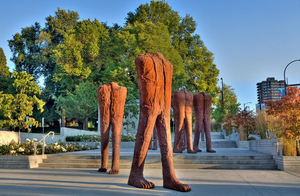Arts on the Ave, Vancouver Biennale, and TELUS to Reveal WALKING FIGURES
The reveal will take place on Wednesday, November 4 at 10:30am.

Arts on the Ave, Vancouver Biennale, and TELUS will present great reveal of Walking Figures, a group of headless, cast-iron figures by Polish artist Magdalena Abakanowicz at the TELUS building on Alberta Avenue (118th avenue and 89th street) on Wednesday, November 4 at 10:30am.
There will be remarks from Arts on the Ave, TELUS, representatives from the Edmonton Polish community, and community leadership before we unveil the statues. COVID-19 protocols will be in place including masks, physical distancing, & individual photos with the statues.
Walking Figures is part of a series of artworks on loan from the Vancouver Biennale to Arts on the Ave as part of their efforts to transform the Alberta Avenue neighbourhood into a community arts district.
About the Artwork
Walking Figures appear to be walking aimlessly without sight, and the sombre tone makes reference to both time and loss. A larger group of figures, cast simultaneously in the artist's studio, is titled Agora and is on permanent display in Chicago's Grant Park. An agora was a meeting place in ancient Greece where the concept of democracy began. There was no citizen above the law, and everyone had power to vote. It was an unbiased way of life. This sculpture is a Legacy Artwork from the 2005-2007 Vancouver Biennale.
About artist Magdalena Abakanowicz
Magdalena Abakanowicz, a distinguished European artist who was active in the field of sculpture for over sixty years, passed away in April 2017. Born in Poland in 1930 to an aristocratic family, she lived through WWII and the Soviet occupation. The magnitude of social and political upheaval left a lasting impact on the artist and her work. Her most recognizable artwork is based on large-scale fragmented human figures (heads without trunks, bodies without heads, torsos without legs), which were developed beginning in the 1970s. These figures are often installed in large groups; however, each sculpture includes individualized details of texture and patterns. These organic details deal with the notion of "the countless" where quantity is overwhelming and the struggle for individuality within the crowd presents itself.
Abakanowicz studied fine art at the University of Warsaw from 1950 to 1954. During her lifetime she received honorary awards from the Royal College of Arts in London and the Academy of Fine Art in Lodz, Poland. Her works have been presented in over forty one-woman exhibitions across the world, and numerous artworks are on display in public sites throughout the United States. In addition, major museums and institutions such as the Art Institute of Chicago, Centre Georges Pompidou (Paris), the Metropolitan Museum of Art (New York), the Museum of Modern Art (New York), and the Australian National Gallery of Art (Canberra) include works by Abakanowicz in their collections.
Comments
.png)
|
.png)
|
Videos

